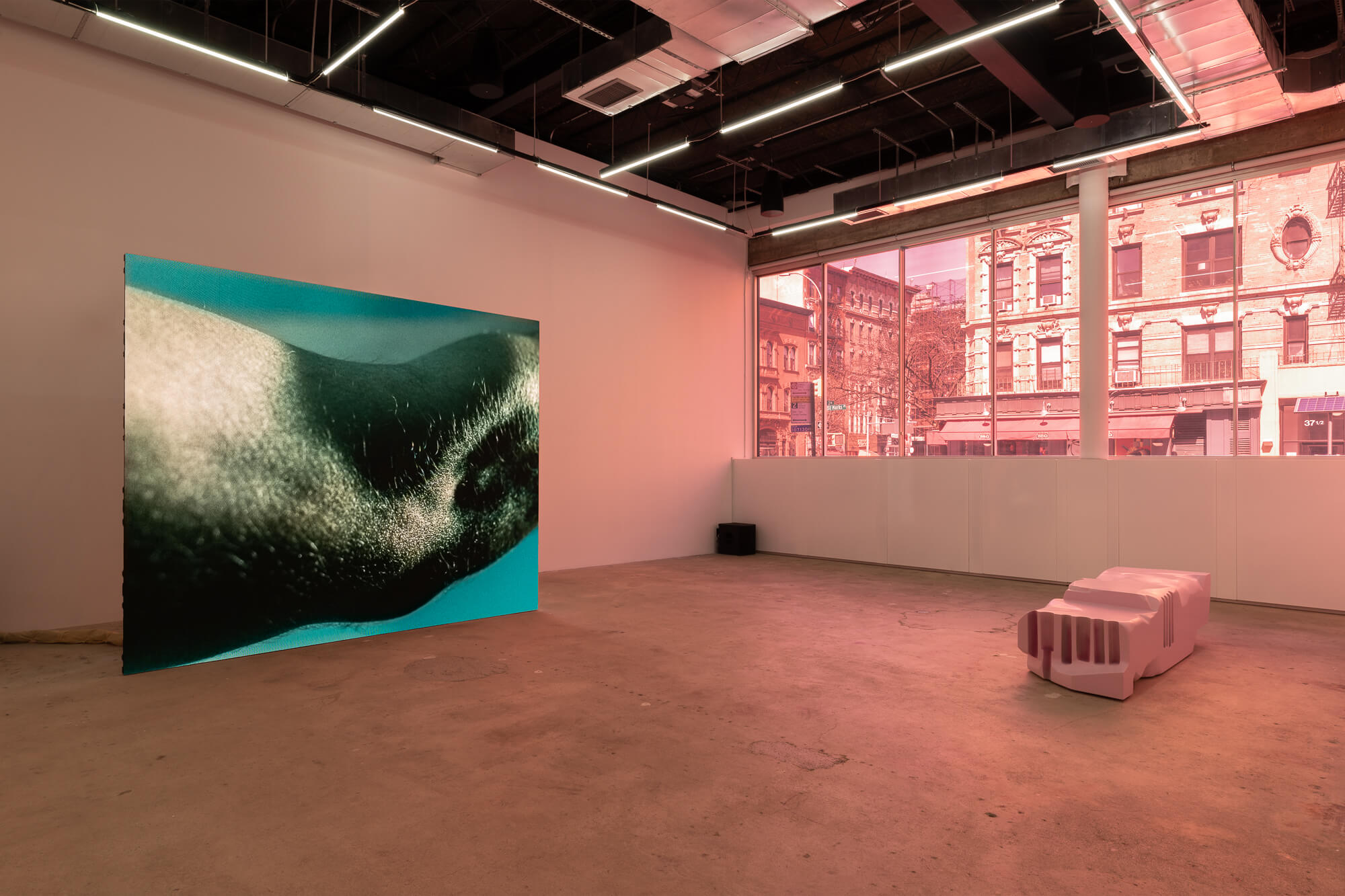Shahryar Nashat | Contemporary Art Review LA
May 01 2019

Shahryar Nashat deals in desire—not a Koonsian, flashy, buy-it-now kind, but rather like a digital enticement, giving the viewer bits of a story, and leaving them wanting more. In his self titled show at Swiss Institute in New York, interest is piqued as refined glimpses of a narrative emerge in the details of each work; this narrative expands across the exhibition, but never fully coalesces. It is this lack of resolution by which we are propelled through the show’s arc of obsession, power struggle, and heartbreak to forge an intimate connection to the implied body within Nashat’s sculptures.
In the first gallery, a pink light radiates through the water-speckled windows (which were film-tinted for the show), illuminating a sculpture called Start To Beg (all works 2019). The sculpture, made from pink synthetic polymer, fiberglass, and atomized acrylic, takes on the form of a bench, but one with bulbous deformities and missing sections that resemble large bite marks or scratches. This first implication of the body in the exhibition—by way of an object with which we regularly interact—sets a tone: the artist implies a certain brand of intimacy that is laced with hazard. The bench sculpture looks both sleek and somehow defiled.
Nearby in this rosetinted room is a video work on one of Nashat’s signature LED walls—a freestanding screen made up of multiple LED monitors—called Keep Begging. The work focuses first on the crook of an arm—a zoomed in shot depicts its every slight twitch, hair, pore, freckle, and vein. While it is at first discomforting to gaze on a body zoomed in to such close proximity, it quickly becomes normalized.
Next, an oddly soothing voice proclaims, “Holidays are over.” And then in a different tone, “Holidays are over. Oops.” With this admission of fault, the arm begins to bend at the elbow, the angle of the camera changes, the light flickers, the music quickens, and the veins pump. The movement is jarring, eradicating much of the comfortable connection that has been built with the subject, forcing the viewer to begin forging a different type of connection with the film.
In the narrative that is built between viewer and the implied figures in Nashat’s exhibition, this is the first lover’s quarrel—the first time one is forced to reconsider their idea of the body that they have come to know. Eventually the camera settles again on an armpit, slowing back down to a familiar pace. Words once again emanate from the speaker by the screen, “Do we go to war?” And then again, more sweetly, “My dear, do we go to war?” Through these words, Nashat introduces the possibility for interpersonal strife. I almost felt compelled to shout, “No, we should not go to war!” in the middle of the gallery, as if the voice in the film and I were having a direct dialogue. With the simple introduction of the word “we,” the viewer and the figure/ voice in the film enter into a power dynamic, warring in conflicting desires for familiarity and distance.
In the next gallery, Rib is a set of four papier-maché sculptures, loosely shaped like wish bones or walkers and standing abjectly in the corner. After being immersed in the high production value of Keep Begging, it’s startling to come across this lowly set of papier-maché forms. One of the sculptures is literally bandaged (with gauze wrapped around its ankle) and it evokes a sense of guilt—after being an active participant while watching the nearby film, we ponder our involvement in the defiling of this anthropomorphized sculpture.
With the three final works in the show, all called Bone In, Nashat uses synthetic polymer, PVC, pigment, and paper to construct highly realistic pieces of meat on a slab, bandaged in cellophane, with snippets of paper beneath their clear casing. The paper contains phrases such as “Since I met you I’ve been trippin” and “This could be us but you’re playin.” Here, the “we” has been revoked and instead the relationship is severed into an icy “you” and “I.” The sculptures act as a break-up—this relationship was only meant for the duration of the show. The greatest success of Nashat’s exhibition isto depict something truly human though objects that are deeply engaged with technology and synthetics.
Evoking emotions such as yearning, intimacy, and desire with a subject that never fully materializes, but is alluded to by multiple new media, suggests where culture is headed and tests the boundaries of our own humanity. As our communications become more truncated and digitized, Nashat is astute in his observations of a human need to bond. As with some interpersonal relationships, specifically the variety played out across dating apps or Instagram, this one builds on fragments, some fraught and flawed, leaving a feeling both distancing and deeply intimate.
by Christie Hayden
